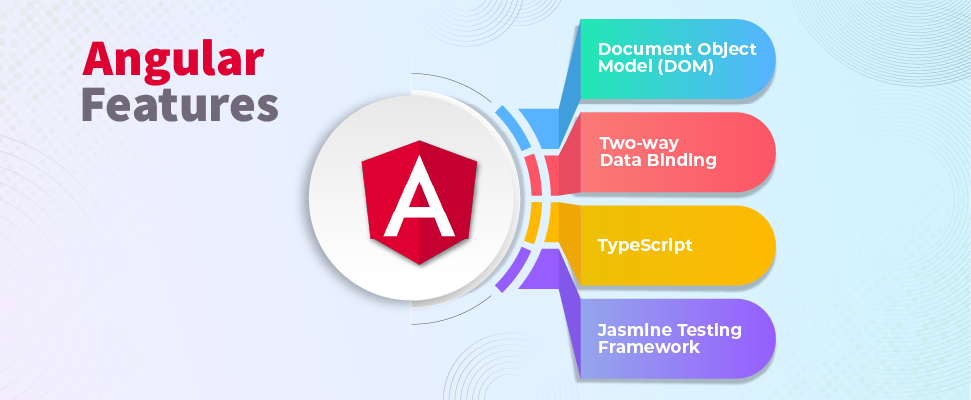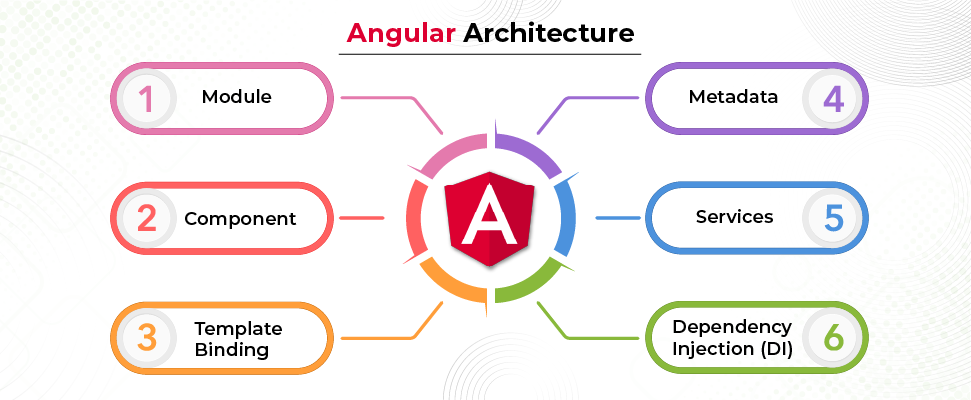Table of Contents
ToggleIntroduction
Times have changed so rapidly that every individual around the globe heavily depends on mobile apps and the web for their day-to-day activities. From healthcare, e-commerce, and online banking to getting a ride, everything that we need is right at our fingertips. But have you ever wondered? How are these apps developed and what is the secret behind this reliability? Well, thanks to frameworks like Angular for providing robust features to create apps and user interface (UI).

Don't miss out on your chance to work with the best
apply for top global job opportunities today!
Angular

Angular is an open-source JavaScript framework mainly designed to build single-page applications. Using Angular for web development ensures enhanced performance and consistent structure. Plus, it saves a lot of time as it doesn’t involve lengthy coding.
What Makes Angular Superior?
JavaScript language is sought after for its easiness among developers. Its well-designed application perfectly aligns with modern-day applications. Perhaps, it’s not ideal for developing a single-page application. It is a tough call for JavaScript solely to handle modularity, testability, and developer productivity.
Nowadays, there is no shortage of frameworks and libraries that provide the ultimate solution for such issues. In terms of front-end development, Angular resolves most of the issues while working with JavaScript.
Also Recommended: 16 Best React.js Frameworks to Use in 2023
How Many Versions Does Angular Has?
Angular was developed in the year 2009. Since then it has been continually evolving. The table below outlines versions of Angular:
| Versions | Year |
|---|---|
| Angular 1 also known as AngularJS | 2010 |
| Angular 2 | 2016 |
| Angular 4 and 5 | 2017 |
| Angular 6 and7 | 2018 |
| Angular 8 and 9 | 2019 |
| Angular 10 and 11 | 2020 |
| Angular 12 | 2021 |
Angular Features

- Document Object Model (DOM): Angular uses the hierarchical DOM representation for web pages. This DOM approaches XML and HTML in a tree structure in memory, where each node represents a part of the document such as element, attribute, and text content. Developer can access the DOM using JavaScript to manipulate the specific elements through code to traverse the tree and then respond to the user interaction. Whenever the changes occur Angular checks the entire components of the tree and updates them. As a result, this ensures the consistency of the entire view and improves the performance.
- Two-way Data Binding: Angular uses this approach to ensure the changes made in the model are automatically reflected in the corresponding UI elements. This feature helps developers with easy synchronization of UI without writing lengthy code to handle updates.
- TypeScript: It is a statically typed superset of JavaScript that allows developers to define the shape and behavior of data without any ambiguity. TypeScript code is compatible with all JavaScript platforms. While it is not always mandatory to use TypeScript to build Angular applications, it’s highly recommended as it provides code quality, robust tooling support, and better maintainability. You can easily install the Node Package Manager (NPM) package to use TypeScript.
- Jasmine Testing Framework: This feature provides many functionalities to create different types of test cases. Also, these test cases ensure correctness in Angular applications. Jasmine Testing Framework uses Karma to execute tests and specify various configuration settings that determine how tests should execute and report.
Angular Architecture

Angular uses a Model View Controller (MVC) framework, where the model represents the business logic of the application. Similarly, the view represents the UI presentation of the application, and the controller manages user input as well as acts as a middleman between model and view. This robust implementation of Angular provides better maintainability and scalability. Let’s have a look at the 8 building blocks of Angular architecture.
- Module: It helps in managing the code base in an organized way by encapsulating each module-specific feature within your application. It uses AppModule which is often known as root module. This AppModule provides all the necessary configurations to bootstrap and determine whether components and settings are loaded or not.
- Component: It plays a crucial role in managing the functionality and structure of the UI. Each component class holds an application logic and data where logic includes the user’s interaction and API request to handle the processing of data. Likewise, data includes the local component fetched from external sources. Overall, each component has the responsibility to render a specific part of the UI. Moreover, this component is further implemented as a class, which combines the application logic and data with a corresponding part of the user interface.
- Template Binding: The main purpose of template binding is to manipulate HTML elements. This merges Angular-specific markup with regular HTML to create dynamic and interactive web applications. Angular uses two types of data binding i.e., event binding and property binding.
- Event Binding: This enables developers to respond to user interaction. Whenever an event occurs in the UI, a developer can use this type of binding to trigger the specific action or function.
- Property Binding: This allows dynamic updating of the attributes and properties of HTML elements based on the data in the application. Developers don’t have to hardcode values into the HTML elements. When the changes occur the corresponding HTML elements automatically update the necessary changes and reflect the current state of the application.
- Metadata: It plays a significant role in configuring and determining the behavior of various elements. Its primary purpose is to decorate classes and gather more information in compilers and runtime. Further, it helps the application to comprehend its classes, directives, components, and more.
- Services: It is a fundamental part of building robust Angular applications. Their role in centralizing and sharing the logic, functionality, and data across various components is critical. By doing so, it promotes code reusability and maintainability.
- Dependency Injection (DI): The role of the DI in Angular architecture is pivotal. It largely helps in managing the dependencies of the application within its component. Moreover, it separates the tasks of different parts of the application and makes code more testable, modular, and maintainable.
Though Angular is a leading web application development language, it also has its cons. In this next section we will see the pros and cons of Angular:
 Pros Pros |  Cons Cons |
|---|---|
| Custom components with rendering logic | Poor accessibility |
| Testability and reusability | Limited SEO options |
| Seamless data handling and event handling | Highly verbose |
| Comprehensive framework | Complex migrating legacy JavaScript/jQuery |
| Enhanced modularity and injectability | Complex front-end tools |
| Pre-built tools for server communication and routing | Steep learning curve |
| Cross-platform compatibility |
Take control of your career and land your dream job
sign up with us now and start applying for the best opportunities!

Companies That Use Angular

Many leading firms such as:
– Google
– Nike
– HBO
– Upwork
And many more heavily depend on Angular.
Benefits of Angular

- Angular has modern web platform capabilities that provide high performance, easy installation, and offline working options.
- It supports the framework Cordova, Ionic, or NativeScript to allow seamless cross-platform mobile development.
- Developers can create a desktop-installed application with the same development technique and also access native OS API on Linux, MAC, and Windows.
- It comes with SEO optimization features that ensure content is accessible and discoverable to search engine crawlers.
- Angular uses advanced JavaScript virtual optimization that tremendously helps in productivity alongside preventing drawbacks in the framework.
- It offers simplified UI development that minimizes the complexity of designing UI.
- It supports editor and IDE support provides intelligent code completion and instant error feedback.
- Lastly, it offers ARIA-compliant components, developer guides, and built-in accessibility (a11y) test infrastructure for people with disabilities.
Final words
Angular is a powerful framework that offers Angular developers robust features and convenience to build single-page applications. Its architecture promotes template binding, components, DJ, and modules to enhance the user’s experience. Despite many advantages, it faces a lot of challenges in accessibility, verbosity, and SEO. As the famous computer science pioneer, Grace Hopper, said, “The most dangerous phrase in the language is, ‘We’ve always done it this way.” So the long-term relevance of Angular depends on its ability to change and adapt to the growing demands.
FAQs
Angular is a TypScript open-source framework to create performant mobile and desktop apps. AngularJS is an open-source JavaScript framework mainly used for single-page web applications that change static HTML to dynamic. AngularJS uses hierarchical dependency injection in its system. However, Angular does not use it in its system.
First, it offers robust documentation, supports HTML, and boasts its rich libraries. Secondly, it promotes code reusability which accelerates the performance and reduces load time.
Angular applications and Angular depend on third-party packages for some features and functionality. These packages are installed with the Node Package Manager (npm).
Both Angular and React have features and tools that help developers create robust apps. React’s simplicity, performance, and flexibility make it a popular choice for many developers. However, Angular’s robust ecosystem and scalability appeal to larger corporate projects.

